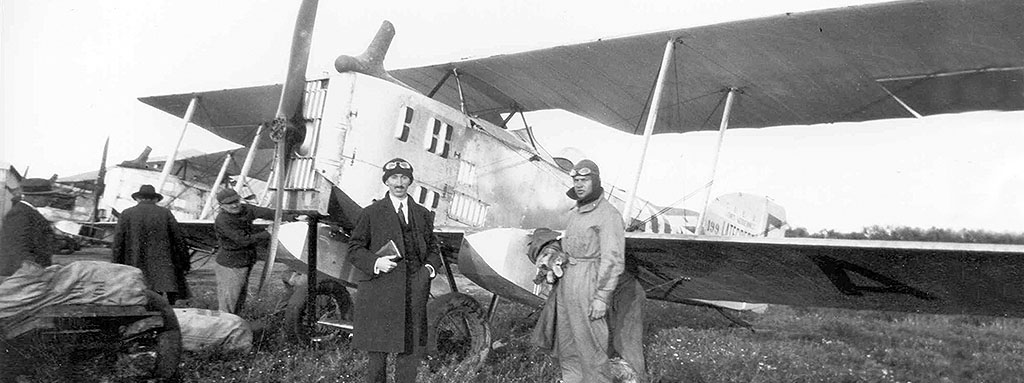When, on 1st September 1919, the Breguet XIV of Lignes Aériennes Latécoère carried out the first flight on the Toulouse, Barcelona, Alicante, Malaga and Casablanca air route, very few people believed in this new mode of transport. This was the first commercial air route in Spain, and the third to be developed in Europe.
In 2018, more than 2.3 million flights operated in Spanish airports, carrying a total of 263 million passengers. Along the way, science and technology have been successfully intertwined, and there has been a transformation of the general world view in terms of its political, socioeconomic and even anthropological aspects.
The biplanes of 1919 reached speeds of little more than a hundred kilometres per hour, and airports were mere wastelands free of trees and shrubs.
Planes were made of wood and fabric, and both the pilot and the sole passenger they carried travelled in the open air. The meagre air services that existed were maintained by the governments of the different countries involved, who used this new mode of air transport as a pawn in their industrial, geopolitical and economic strategies.
However, Spanish citizens, caught in the middle of the economic crisis caused by the Great War, were more worried about food shortages and rising prices, and air transport was a long way away from their lives.
The nationalisation of air transport gave rise to flag carriers. In Spain, the French company Latécoère was joined in 1921 by the Compañía Española de Tráfico Aéreo (CETA), which began to operate on the Seville-Larache route, transporting mail and providing services to the military authorities of the Protectorate of Morocco. In the mid-1920s, it was the German companies Unión Aérea Española and Iberia that became part of the fledgling national air transport network, creating the Seville, Madrid, Lisbon and Madrid, Barcelona routes, respectively. However, their real interest lay in flying from Europe to South America, circumventing the embargo imposed by the Treaty of Versailles.
Government interest gave rise to the big international airlines: Imperial Airways, Air France and Deutsche Luft Hansa.
The Spanish Government followed in the footsteps of its European neighbours and imposed a merger of the existing companies, leading to the creation of CLASSA (Concesionaria de Líneas Aéreas Subvencionadas, meaning Subsidised Airline Concessionaire) in 1929. In 1931, the republican government converted this limited company into LAPE (Líneas Aéreas Postales Españolas, meaning Spanish Postal Airlines), which was the first company to generalise air transport in this country.
The appearance of new models of metal aircraft, especially the ubiquitous North American DC-2, served to consolidate national and international air transport, thanks to a substantial improvement in air navigation systems, airport facilities and the profitability of the service.
In Spain, air transport was still reserved for mail and a few economically and socially elite passengers.
Once again, it was the technological advances brought by the Second World War that initiated a new stage for commercial air transport. Powerful new engines and pressurised cabin systems enabled the star aircraft of the time, the Lockheed L-049 Constellation and the DC-6, to overcome adverse weather conditions and reach speeds of over 500 km/h. The appearance in 1952 of the first jet aircraft (Comet I) marked a turning point in international commercial aviation.
These aircraft improvements led to lower airfares, which in turn led to increased demand, especially on transatlantic routes.
In Spain, the state-owned company Iberia was joined, in 1946, by the short-lived CANA and, in 1948, by Aviación y Comercio (Aviaco), which a few years later became integrated with Iberia under the umbrella of the Instituto Nacional de Industria (INI, National Institute of Industry).
It was the increase in demand that, in the mid-1950s, prompted companies to establish the first economy class fares. The recovery of the European economy after the post-war period, as well as the generalisation of paid holidays, led to an increase in the demand for air transport, which resulted in the approval of charter flights in 1956.
Their proliferation changed the framework of air transport in Europe, and particularly in Spain. Dozens of companies began flying to this country, giving rise to a new social and economic phenomenon: tourism.
The development of charter flights was accompanied by a substantial improvement in airports and navigation systems, a phenomenon that not only transformed transport and the economy of tourist destinations (such as Palma de Mallorca, Benidorm or Torremolinos), but also helped to relax the rigid rules that existed in Spain in both the social and political field, given the dependence of its fragile economy on foreign money. The tourists who arrived on charter flights were the catalysts of an unprecedented change in a closed and shadowy society.
The state-owned companies Iberia and Aviaco were joined by companies such as Spantax, Air Spain and Transeuropa, and large jets arrived at Spanish airports in unison, such as the DC-8 and, later, the B-747.
After the energy crises of the 1970s and 1980s, air transport began a new period of expansion that culminated in the deregulation of the sector, first in the United States (1976) and then in Europe (1991).
Within this new framework, new and numerous point-to-point service companies emerged, popularly known as “low-cost” companies, while traditional and distribution companies became grouped into large global alliances: OneWorld, Sky Team and Star Alliance.
The first years of the 21st century saw a notable resurgence of air transport throughout Spain. Practically all airports have had to adapt their facilities to a growing demand for services and companies, now European in scope. EasyJet or Ryanair have capitalised on air transport in Spain, pushing national companies such as Iberia, Air Europa, Vueling or Air Nostrum into the background.
Thus, a mode of transport that was born a century ago from our dreams of soaring through the skies has now become an essential element in the development of contemporary societies.
The millions of airways that cross the planet every day are a reflection not only of the mobility provided by air travel, but also of a new conception of society. Our current labour, social, holiday and sport models cannot be conceived, nor perhaps would they exist as they do today, without air transport.
However, the development of air transport has only just begun.
It is reasonable to think that, in the coming decades, new technology will give rise to collective aircraft, efficient private and single-seater aircraft, and aircraft for domestic transport of goods.
In the coming decades, automatic flights, based on efficient satellite systems, as well as experimental suborbital flights, will be added to today’s manned flights.
In short, in barely a century of development, air transport has become one of the pillars of our society.



